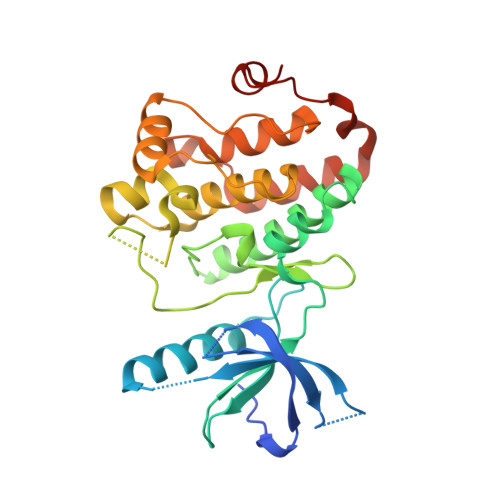Back-Pocket Optimization of 2-Aminopyrimidine-Based Macrocycles Leads to Potent EPHA2/GAK Kinase Inhibitors.
Gerninghaus, J., Zhubi, R., Kramer, A., Karim, M., Tran, D.H.N., Joerger, A.C., Schreiber, C., Berger, L.M., Berger, B.T., Ehret, T.A.L., Elson, L., Lenz, C., Saxena, K., Muller, S., Einav, S., Knapp, S., Hanke, T.(2024) J Med Chem 67: 12534-12552
- PubMed: 39028937
- DOI: https://doi.org/10.1021/acs.jmedchem.4c00411
- Primary Citation of Related Structures:
8QQY - PubMed Abstract:
Macrocyclization of acyclic compounds is a powerful strategy for improving inhibitor potency and selectivity. Here we have optimized 2-aminopyrimidine-based macrocycles to use these compounds as chemical tools for the ephrin kinase family. Starting with a promiscuous macrocyclic inhibitor, 6 , we performed a structure-guided activity relationship and selectivity study using a panel of over 100 kinases. The crystal structure of EPHA2 in complex with the developed macrocycle 23 provided a basis for further optimization by specifically targeting the back pocket, resulting in compound 55 , a potent inhibitor of EPHA2/A4 and GAK. Subsequent front-pocket derivatization resulted in an interesting in cellulo selectivity profile, favoring EPHA4 over the other ephrin receptor kinase family members. The dual EPHA2/A4 and GAK inhibitor 55 prevented dengue virus infection of Huh7 liver cells. However, further investigations are needed to determine whether this was a compound-specific effect or target-related.
- Institute of Pharmaceutical Chemistry, Goethe University, Max-von-Laue-Str. 9, Frankfurt am Main 60438, Germany.
Organizational Affiliation:


















